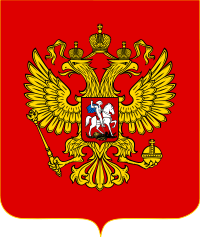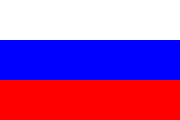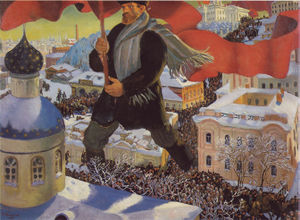Russian Provisional Government
|
|||||||||||||||||||||||||||||||||||||||||||||||||||||||||||||||||||||||||||||||
| History of Russia | |
|---|---|
 This article is part of a series |
|
| Volga Bulgaria (7th–13th) | |
| Khazars (7th–10th) | |
| Rus' Khaganate (8th–9th) | |
| Kievan Rus' (9th–12th) | |
| Vladimir-Suzdal (12th–14th) | |
| Novgorod Republic (12th–15th) | |
| Mongol invasion (1220s–1240s) | |
| Tatar Yoke (13th–15th) | |
| Grand Duchy of Moscow (1340–1547) | |
| Tsardom of Russia (1547–1721) | |
| Russian Empire (1721–1917) | |
| Russian Provisional Government / Russian Republic (1917) | |
| Soviet Russia / Soviet Union (1917–1991) | |
| Russian Federation (1992–present) | |
|
Russia Portal |
The Russian Provisional Government (Russian: Временное правительство России, Vremennoye pravitel'stvo Rossii) was the short-lived administrative body which sought to govern Russia immediately following the abdication of Tsar Nicholas II in March 1917 (Nicholas' manifest of abdication).[2][3] On September 14, the State Duma of the Russian Empire was officially dissolved by the newly created Directorate, and the country was declared the Russian Republic (Russian: Российская республика, Rossiyskaya respublika). It is also sometimes known as the "Kerensky Government" after its most prominent leader. It lasted approximately eight months, and ceased to exist after power in Russia was transferred to the Soviets by the Bolsheviks in October 1917.
The Provisional Government was formed in Petrograd, and was led first by Prince Georgy L'vov and then by socialist Alexander Kerensky, a prominent member of the Duma and a leader of the movement to unseat the Tsar. Instead of ending Russia's involvement in World War I, the new government launched a fresh offensive against the German and Austro-Hungarian army in July 1917, thereby weakening its popularity among Russia's war-weary people. This Kerensky Offensive, as it was called, was a failure which further eroded support for the government. The Provisional Government was unable to make decisive policy decisions due to political factionalism and a breakdown of state structures.[4] This weakness left the government open to strong challenges from both the right and the left. The Provisional Government's chief adversary on the left was the Petrograd Soviet, which tentatively cooperated with the government at first, but then gradually gained control of the army, factories, and railways.[5] The period of competition for authority ended in late October 1917, when Bolsheviks routed the ministers of the Provisional Government in the events known as the October Revolution, and placed power in the hands of the soviets, or "workers' councils," which they largely controlled.
The weakness of the Provisional Government is perhaps best reflected in the derisive nickname given to the Minister of War Alexander Kerensky: "persuader-in-chief." [6]
Contents |
World recognition
- United States - March 22, 1917
- France, Great Britain, and Italy - March 24, 1917
Formation and initial composition
When the authority of the Tsar's government began disintegrating after the February Revolution of 1917, two rival institutions, the Duma and the Petrograd Soviet, competed for power. Tsar Nicholas II abdicated on March 2 (Julian calendar) and nominated his brother, Grand Duke Michael as the next tsar. Grand Duke Michael did not want to take the poisoned chalice[7] and deferred acceptance of imperial power the next day. Legal authorization for the transfer of power was given by a proclamation signed by Grand Duke Michael. The Provisional Government was expected to rule until the Constituent Assembly later determined the form of government in Russia. The Provisional Government was designed to set up elections to the Assembly while maintaining essential government services, but its power was effectively limited by the Petrograd Soviet's growing authority.
Public announcement of the formation of the Provisional Government was made. It was published in Izvestia the day after its formation.[8]
Initial composition of the Provisional Government:
| Post | Name | Party |
|---|---|---|
| Minister-President and Minister of the Interior | Georgy Lvov | |
| Minister of Foreign Affairs | Pavel Milyukov | Kadet |
| Minister of War and Navy | Alexander Guchkov | Octobrist |
| Minister of Transport | Nikolai Nekrasov | Kadet |
| Minister of Trade and Industry | Alexander Konovalov | Progressist |
| Minister of Justice | Alexander Kerensky | Socialist-Revolutionary Party |
| Minister of Finance | Mikhail Tereshchenko | Non-Party |
| Minister of Education | Andrei Manuilov | Kadet |
| Minister of Agriculture | Andrei Shingarev | Kadet |
| Ober-Procurator of the Holy Synod | Vladimir Lvov | Progressist |
April crisis and first coalition government
On April 18 (May 1) minister of Foreign Affairs Pavel Milyukov sent a note to the Allied governments, promising to continue the war to 'its glorious conclusion'. On April 20 and 21 massive demonstrations of workers and soldiers erupted against the continuation of war. Demonstrations demanded resignation of Milyukov. They were soon met by the counter-demonstrations organised in his support. General Lavr Kornilov, commander of the Petrograd military district, wished to suppress the disorders, but premier Georgy Lvov refused to resort to violence.
The Provisional Government accepted the resignation of Foreign Minister Milyukov and War Minister Guchkov, and made a proposal to the Petrograd Soviet to form a coalition government. As a result of negotiations, on May 5 (18) agreement was reached and 6 socialist ministers joined the cabinet.
Composition of the first coalition government:
| Post | Name | Party |
|---|---|---|
| Minister-President and Minister of the Interior | Georgy Lvov | |
| Minister of Foreign Affairs | Mikhail Tereshchenko | Non-party |
| Minister of War and Navy | Alexander Kerensky | Socialist-Revolutionary Party |
| Minister of Transport | Nikolai Nekrasov | Kadet |
| Minister of Trade and Industry | Alexander Konovalov | Progressist |
| Minister of Justice | Pavel Pereverzev | Socialist-Revolutionary Party |
| Minister of Finance | Andrei Shingarev | Kadet |
| Minister of Education | Andrei Manuilov | Kadet |
| Minister of Agriculture | Victor Chernov | Socialist-Revolutionary Party |
| Minister of Labour | Matvey Skobelev | Menshevik |
| Minister of Food | Alexey Peshekhonov | National socialists |
| Minister of Post and Telegraph | Irakli Tsereteli | Menshevik |
| Ober-Procurator of the Holy Synod | Vladimir Lvov | Progressist |
During this period the Provisional Government merely reflected the will of the Soviet, where left tendencies (Bolshevism) were gaining ground. The Government, however, influenced by the "bourgeois" ministers, tried to base itself on the right wing of the Soviet. Socialist ministers, coming under fire from their left wing Soviet associates, were compelled to pursue a double-faced policy. The Provisional Government was unable to make decisive policy decisions due to political factionalism and a breakdown of state structures.[4]
July crisis and second coalition government
July crisis took place in Petrograd between July 3 and 7 (Julian calendar) (July 16–July 20, Gregorian calendar), when soldiers and industrial workers in the city rioted against the Provisional Government. After the rising was put down, the Bolsheviks were blamed for it, and their leader Vladimir Lenin went into hiding, while other leaders were arrested.[9]
The result of the events was new protracted crisis in the Provisional Government. "Bourgeois" ministers, belonging to the Constitutional Democratic Party resigned, and no cabinet could be formed to the end of the month. Finally, on August 6 (July 24) 1917, a new coalition cabinet, composed mostly of socialists, was formed with Kerensky at its head.
Second coalition:
| Post | Name | Party |
|---|---|---|
| Minister-President and Minister of War and Navy | Alexander Kerensky | Socialist-Revolutionary Party |
| Vice-President, Minister of Finance | Nikolai Nekrasov | |
| Minister of Foreign Affairs | Mikhail Tereshchenko | Non-party |
| Minister of Internal Affairs | Nikolai Avksentyev | Socialist-Revolutionary Party |
| Minister of Transport | Piotr Yurenev | Kadet |
| Minister of Trade and Industry | Sergei Prokopovich | Non-party |
| Minister of Justice | Alexander Zarudny | National socialists |
| Minister of Education | Sergey Oldenburg | Kadet |
| Minister of Agriculture | Victor Chernov | Socialist-Revolutionary Party |
| Minister of Labour | Matvey Skobelev | Menshevik |
| Minister of Food | Alexey Peshekhonov | National socialists |
| Minister of Health Care | Ivan Efremov | |
| Minister of Post and Telegraph | Alexei Nikitin | Menshevik |
| Ober-Procurator of the Holy Synod | Vladimir Lvov | Progressist |
Third coalition
From October 8 (September 25), 1917.
| Post | Name | Party |
|---|---|---|
| Minister-President | Alexander Kerensky | Socialist-Revolutionary Party |
| Vice-President, Minister of Trade and Industry | Alexander Konovalov | Kadets |
| Minister of Foreign Affairs | Mikhail Tereshchenko | Non-party |
| Minister of Internal Affairs, Post and Telegraph | Alexei Nikitin | Menshevik |
| Minister of War | Alexander Verkhovsky | |
| Minister of Navy | Dmitry Verderevsky | |
| Minister of Finance | Mikhail Bernatsky | |
| Minister of Justice | Pavel Malyantovitch | Menshevik |
| Minister of Transport | Alexander Liverovsky | Non-party |
| Minister of Education | Sergei Salazkin | Non-party |
| Minister of Agriculture | Semen Maslov | Socialist-Revolutionary Party |
| Minister of Labour | Kuzma Gvozdev | Menshevik |
| Minister of Food | Sergei Prokopovich | Non-party |
| Minister of Health Care | Nikolai Kishkin | Kadet |
| Minister of Post and Telegraph | Alexei Nikitin | Menshevik |
| Minister of Religion | Anton Kartashev | Kadet |
Kornilov affair
The Kornilov coup affair in August 1917 became the last nail in the coffin of the Provisional Government. Due to the extreme weakness of the government at this point, there was talk among the elites of bolstering its power by including the Commander-in-chief of Russian army Lavr Kornilov as a military dictator on the side of Kerensky. The extent to which this deal had indeed been accepted by all parties is still unclear. What is clear, however, is that when Kornilov's troops approached Petrograd, Kerensky branded them as counter-revolutionaries and demanded their arrest. This move can be seen as an attempt to bolster his own power by making him a defender of the revolution against a Napoleon-type figure. However, it had terrible consequences, as Kerensky's move was seen in the army as a betrayal of Kornilov, making them finally disloyal to the Provisional Government. Furthermore, as Kornilov's troops were arrested by the now armed Red Guard, it was the Soviet that was seen to have saved the country from military dictatorship.
The October Revolution

On October 24-25 (by the Julian Calendar, whose use has since been discontinued in Russia), Red Guard forces under the leadership of Bolshevik commanders launched their final attack on the ineffectual Provisional Government. Most government offices were occupied and controlled by Bolshevik soldiers on the 24th; the last holdout of the Provisional Ministers, the Tsar's Winter Palace on the Neva River bank, was captured on the night of the 25th. Kerensky escaped the Winter Palace raid and fled to Pskov, where he rallied some loyal troops for an attempt to retake the capital. His troops managed to capture Tsarskoe Selo but were beaten the next day at Pulkovo. Kerensky spent the next few weeks in hiding before fleeing the country. He went into exile in France and eventually emigrated to the U.S.
The Bolsheviks then replaced the government with their own.
Some historians, such as Pavel Osinsky, argue that the October Revolution was as much a function of the failures of the Provisional Government as it was of the strength of the Bolsheviks. Osinsky described this as “socialism by default” as opposed to “socialism by design.” [10]
Riasanovsky argued that the Provisional Government made perhaps its "worst mistake"[6] by not holding elections to the Constituent Assembly soon enough. They wasted time fine-tuning details of the election law, while Russia slipped further into anarchy and economic chaos. By the time the Assembly finally met, argued Riasanovsky, "the Bolsheviks had already gained control of Russia."[11]
Further reading
- Kerensky, Alexander. The Catastrophe: Kerensky’s Own Story of the Russian Revolution. New York: D. Appleton and Company, 1927.
- Medvedev, Roi. The October Revolution. New York: Columbia University Press, 1979.
- Nabokov, Vladimir Dmitrievich. V.D. Nabokov and the Russian Provisional Government, 1917. New Haven: Yale University Press, 1976, ISBN 0-300-01820-7
- Reed, John. Ten Days that Shook the World. New York: Boni & Liveright, 1919.
- Riasanovsky, Nicholas. A History of Russia (sixth edition). New York: Oxford University Press, 2000.
- Trotsky, Leon. Lessons of October. New York: Pioneer Publishers, 1937 (1924).
References
- ↑ Declared by Directorate in September 14
- ↑ Manifest of abdication (Russian)
- ↑ "Announcement of the First Provisional Government, 13 March 1917". FirstWorldWar.com. 2002-12-29. http://www.firstworldwar.com/source/firstprovgovt.htm. Retrieved 2007-12-12.
- ↑ 4.0 4.1 "Annotated chronology (notes)". University of Oregon/Alan Kimball. 2004-11-29. http://www.uoregon.edu/~kimball/sac.1917.1920.htm. Retrieved 2007-12-13.
- ↑ Kerensky, Alexander (1927). The Catastrophe— Kerensky’s Own Story of the Russian Revolution. D. Appleton and Company. pp. 126. ISBN 0527491004.
- ↑ 6.0 6.1 Riasanovsky, Nicholas (2000). A History of Russia (sixth edition). Oxford University Press. pp. 457. ISBN 0-19-512179-1.
- ↑ M. Lynch, Reaction and Revolution: Russia 1894-1924 (3rd ed.), Hodder Murray, London 2005, pg. 79
- ↑ "Announcement of the First Provisional Government, 3 March 1917". FirstWorldWar.com. 2002-12-29. http://www.firstworldwar.com/source/firstprovgovt.htm. Retrieved 2007-12-12.
- ↑ Christopher Read (2005) Lenin. London, Routledge: 160-2
- ↑ Osinsky, Pavel. War, State Collapse, Redistribution: Russian Revolution Revisited, Paper presented at the annual meeting of the American Sociological Association, Montreal Convention Center, Montreal, Quebec, Canada August 2006
- ↑ Riasanovsky, Nicholas (2000). A History of Russia (sixth edition). Oxford University Press. pp. 458. ISBN 0-19-512179-1.
|
||||||||||||||||||||||||||||||||||||||||||||


